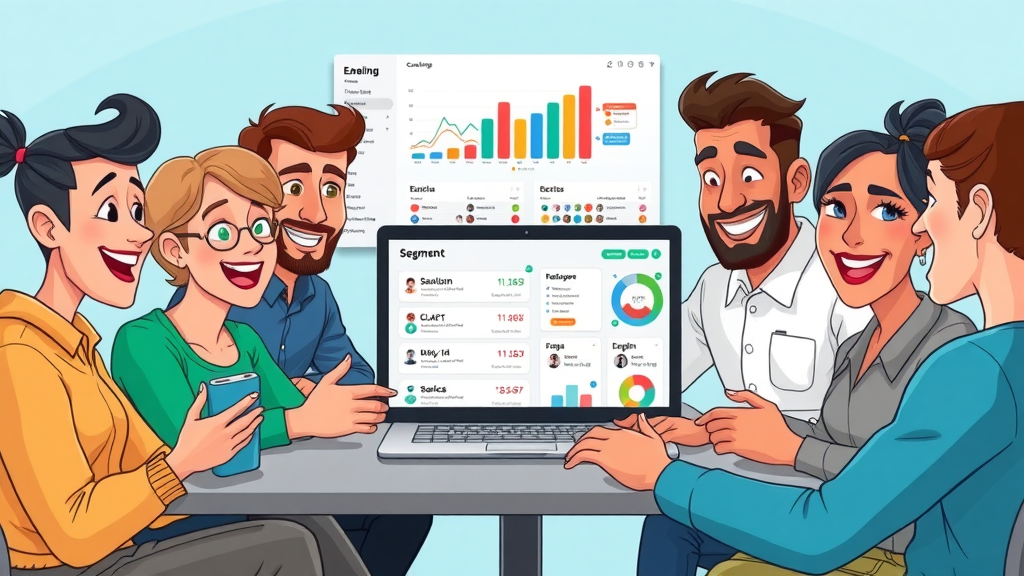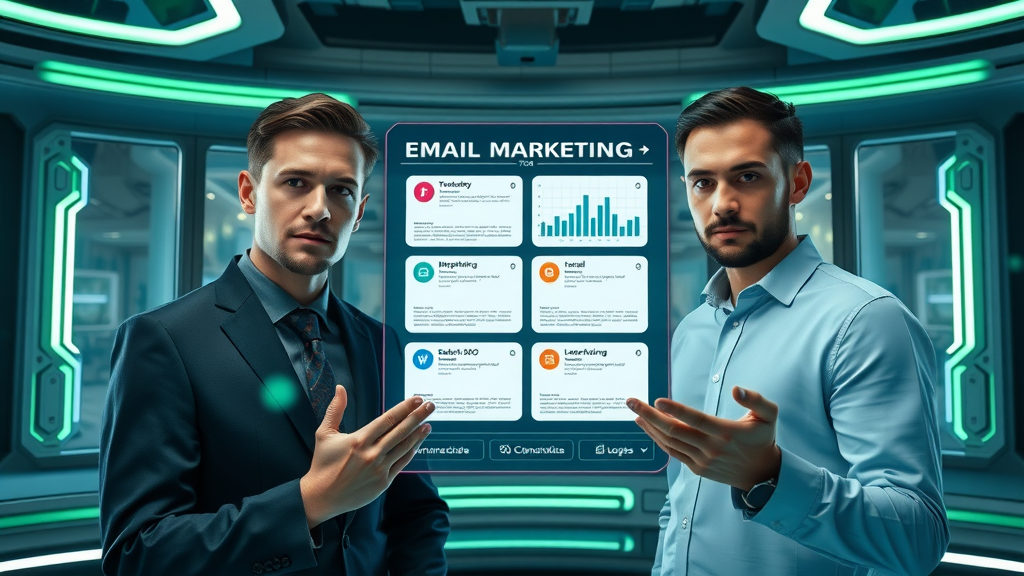Did you know? Businesses that embrace personalized email campaigns enjoy a 27% higher click-through rate and a 760% increase in revenue compared to standard email marketing. If that’s not a wake-up call, what is? In today’s competitive landscape, the difference between generic messages and dynamic, targeted emails is night and day. This guide will show you how easy—and powerful—personalized email marketing can be for your business.

"Marketers who use personalized email campaigns see a 27% higher click-through rate and a 760% increase in revenue."
Startling Facts: Why Personalized Email Campaigns are Transforming Modern Marketing
Personalized email campaigns are no longer just a trend—they’re a necessity for anyone wanting to make their mark in modern marketing. A targeted email sent at the right moment can lead to dramatically increased open rates, improved engagement, and loyalty that pays dividends with every marketing campaign. The secret? Relevant content tailored specifically to your customers’ preferences, behavior, and purchase history.
Many business owners are surprised to learn just how quickly a well-crafted personalized email marketing approach can increase engagement and drive ROI. When you automate and personalize, every marketing campaign feels like a one-on-one conversation—building trust, boosting conversion rates, and keeping your brand top-of-mind. You don’t need to be a tech wizard to get started; with straightforward tools and step-by-step strategies, you can transform your email marketing in as little as a few hours a week.
Introduction to Email Personalization in Email Marketing
Email personalization is the process of using customer data—like their name, location, or purchase history—to create messages that feel tailor-made for each recipient. In the world of email marketing, personalizing emails helps increase open rates and click-through rates dramatically. Instead of generic messages, customers receive offers, recommendations, or content that fits their interests and behaviors. This approach makes them more likely to engage, make a purchase, or stay loyal long term.
Even simple adjustments, like including a customer’s first name in the subject line or suggesting products based on past purchases, can set your email campaigns apart. Email personalization takes traditional “spray and pray” emailing and turns it into a smart, strategic play where every message has a purpose. The goal is clear: deliver more value, create meaningful connections, and drive real results for your business.
Personalized Email Marketing vs Traditional Mass Emails
Traditional mass emails send the same message to your entire list, regardless of each recipient’s interests or behaviors. While this approach is easy, it often leads to lower open rates, lower engagement, and lots of emails hitting the spam or trash folder. Personalized email marketing takes email campaigns to the next level. Using data and segmentation, you send relevant content to specific groups, resulting in higher engagement, better conversion rates, and a more positive brand reputation.
The difference is dramatic: customers who receive personalized emails feel like you know and value them. In contrast, recipients of mass emails often ignore or unsubscribe altogether. By leveraging modern email marketing platforms and a focused marketing strategy, even small businesses can compete with bigger brands—delivering targeted, valuable, and timely messages every step of the way.
What You’ll Learn About Personalized Email Campaigns
- The foundations of personalized email campaigns and their importance
- Step-by-step process of building a targeted email marketing campaign
- Tools and technologies for effective email personalization
- How to craft compelling subject lines and dynamic content
- Ways to track and optimize your open rates
- Practical tips to maximize ROI with minimal technical skill
Understanding Personalized Email Campaigns and Their Impact

What are Personalized Email Campaigns?
Definition and Key Concepts
Personalized email campaigns are targeted email strategies that use customer data, behaviors, and preferences to send highly relevant messages. Unlike traditional campaigns, personalization lets you send content that feels handpicked for each recipient—using names, recent purchases, or browsing history to craft every email. This creates an experience that resonates, resulting in higher open rates and better response rates for your marketing campaigns.
Key elements of email personalization include dynamic content (which changes based on recipient data), segmentation (dividing your audience into relevant groups), and automation tools that streamline the whole process. Whether you’re sending promotional offers, newsletters, or follow-ups, the goal is clear: make every email campaign feel personal, timely, and valuable for your customers.
The Role of Data in Email Personalization
Customer data is the backbone of effective personalized email marketing. Information like names, locations, purchase history, and browsing behavior enables marketers to personalize emails in meaningful ways. Email marketing platforms gather this data when users subscribe, shop, or interact with your website and online content. The more you understand your audience, the easier it becomes to group them, recommend products, and deliver content that sparks action.
Data also powers advanced features like conditional content blocks and automated triggers in your email campaigns, ensuring that every message fits where your customer is in their journey. With careful attention to privacy and transparent opt-in practices, you can use this information to create a marketing strategy that feels authentic, respectful, and effective.
Benefits of Personalized Email Campaigns for Businesses
Boosting Customer Engagement and Loyalty
Personalized emails don’t just drive higher engagement—they help build lasting customer relationships. When an email campaign acknowledges a recipient’s interests, recent purchases, or even their birthday, customers feel seen and valued. This leads to increased open rates and more meaningful brand interactions.
Personalized messages also encourage feedback and conversation, which are essential for developing trust and loyalty. Loyal customers are more likely to purchase, refer friends, and stay engaged with your brand over time. In essence, personalized email marketing is a low-cost, high-reward way to grow your business in a crowded digital world.
Increasing Open Rates and Conversion
One of the most compelling reasons to embrace personalized email campaigns is their proven ability to boost open rates and conversions. When a subject line mentions a recipient’s name or references a recent interaction, the email instantly stands out. Dynamic content based on activities or preferences further increases the chance they’ll act—whether it’s making a purchase, taking advantage of a special offer, or joining an event.
Businesses that shift from generic blasts to highly personalized emails see remarkable improvements in both open rate and conversion metrics. Tailored email content not only captures attention but encourages action, resulting in better ROI and more efficient marketing campaigns.
Core Elements of Personalized Email Campaigns
Targeted Email Segmentation Techniques

Segmentation is the process of dividing your email list into smaller, more targeted groups based on characteristics like demographics, location, purchase history, or behaviors. Targeted email segmentation ensures that every campaign delivers content highly relevant to each segment, dramatically increasing engagement and open rates.
Marketing platforms make it easy to tag and group subscribers, automate triggers, and build segments that update in real time. For example, one segment might receive product recommendations based on past purchases, while another is sent educational content or seasonal promotions. By understanding your audience and organizing your data, you lay the foundation for every other aspect of personalized email marketing success.
Crafting Personalized Subject Lines that Drive Opens
- Using recipient names
- Segment-specific offers
- Formatting tricks
- A/B testing for subject lines
An eye-catching subject line is your first—and sometimes only—chance to get your recipient’s attention. Personalization here can mean simple things like using the subscriber's name, or more advanced tactics like including a local event or mention of a recent purchase. Segment-specific offers (like a 10% birthday discount) show that you know and value your customer beyond just their inbox. Formatting tricks, such as emojis or creative capitalization, can further boost open rates, especially when A/B tested for maximum impact. Small changes in email subject lines can lead to big wins in both open rate and conversion, making every word count.
Creating Dynamic Email Content for Maximum Relevance
Dynamic content takes personalization to the next level by changing what a user sees in an email based on real-time data. Instead of one-size-fits-all email content, you present images, offers, and calls-to-action that are completely customized for each recipient. For example, someone who recently browsed shoes on your website will see footwear product recommendations, while another gets suggestions based on their last purchase or location.
Dynamic content improves the user experience and your conversion rates, ensuring that every email campaign stays fresh, relevant, and valuable to your audience. When your customers receive messages tailored to their specific interests, they’re far more likely to open, click, and convert—making dynamic content a must for modern email marketing.
Automating Personalized Email Marketing Campaigns
Automation removes the manual legwork from your personalized campaigns and ensures you never miss an opportunity to engage your list. With email automation tools, you can trigger specific campaigns based on actions like a new sign-up, a recent purchase, or even a cart abandonment.
Incorporating automation not only saves time but enhances the relevance and timing of your emails, strengthening your overall marketing strategy. Most marketing platforms offer easy-to-use templates and drag-and-drop editors designed specifically for business owners who want to benefit from personalization—without a steep technical learning curve.
Step-by-Step Tutorial: Building Personalized Email Campaigns

Step 1: Define Your Email Campaign Objectives
Before you begin, set clear goals for your personalized email campaign. Do you want to increase open rates, drive sales, re-engage lapsed customers, or grow your subscriber list? Your objectives will determine the type of data you collect, how you segment your audience, and the kind of dynamic content you create. Well-defined goals also make it easier to measure results and make improvements down the line.
Without clarity, your marketing campaign may fall flat—so take time to specify what success looks like for each email campaign. This sets the stage for every other step, keeps your messaging focused, and maximizes your marketing ROI.
Step 2: Gather and Analyze Customer Data
Effective email personalization relies on accurate, up-to-date customer data. Start by collecting information through sign-up forms, purchase history, website activity, and past interactions. Email marketing tools often integrate with your site or CRM to automate this process, ensuring every new subscriber is tagged appropriately from day one.
Once you have enough data, look for patterns—such as products frequently purchased together or content that generates higher engagement. This analysis is key to creating segments and drafting emails that speak directly to what your audience cares about, making each message relevant and timely.
Step 3: Segment Your Audience for Targeted Emails
With your goals and data in place, divide your audience into meaningful groups based on their behaviors, demographics, or engagement history. For example, you may have one segment for repeat buyers and another for window-shoppers who haven’t made a purchase yet. Targeted email segmentation is the backbone of every successful personalized email marketing strategy.
Many marketing platforms offer tools that automate this process, dynamically updating segments as customer data changes. Effective segmentation ensures every campaign is both personal and highly targeted—greatly boosting open rates and conversions for your business.
Step 4: Personalize Email Content and Subject Lines
Now for the fun part: crafting content! Personalize your email content by referencing a recipient’s name, last purchase, or recommended products. For subject lines, experiment with personalization like “Jane, your favorite sneakers are back!” or “Mark, exclusive deal just for you.”
Dynamic content blocks allow you to swap out offers, images, or CTAs based on each segment’s behavior or preferences. A/B testing subject lines and email content will reveal what resonates best with your audience—helping you refine your approach campaign after campaign.
Step 5: Schedule, Test, and Launch Your Personalized Email Campaign
With emails written and segments defined, schedule your campaign to hit inboxes when recipients are most likely to open and engage. Before launching, send test emails to check formatting, dynamic content, and all the personalized fields.
Once live, monitor performance using your marketing platform’s analytics dashboard. Watch open rates, click-through rates, and conversions closely. Use this feedback to refine future campaigns, ensuring your email strategy evolves alongside your audience and your business goals.
Essential Tools for Personalized Email Campaigns
Overview of Popular Email Marketing Platforms
- Mailchimp for personalized emails
- ActiveCampaign’s automation
- HubSpot for dynamic content

Choosing the right marketing platform is critical for launching successful personalized email campaigns. Mailchimp offers easy-to-use personalization and segmentation features for beginners, with templates for tailored product recommendations and dynamic content. ActiveCampaign takes automation one step further, letting you build sophisticated marketing workflows and behavioral triggers. HubSpot stands out for its advanced dynamic content options, making every message feel truly custom.
All these platforms are designed for business owners with limited technical expertise—making it easy to launch, test, and refine targeted email and marketing campaigns with minimal stress. Most offer try-before-you-buy plans, so you can test which fits your workflow best.
Integrating AI for Advanced Email Personalization
"AI-driven personalized email campaigns can dramatically improve relevance and ROI for small businesses."
Artificial intelligence (AI) is transforming how we deliver relevant content in personalized email marketing. AI tools can predict which products a customer will want, intelligently schedule send times for higher open rates, and automate dynamic content for hundreds or thousands of recipients at once.
For small businesses, this means less time spent analyzing data and guessing what customers want—and more time reaping the rewards of a smart, responsive marketing strategy. AI integration can be as simple as enabling predictive analytics in your marketing platform, or as sophisticated as real-time personalization based on customer behavior.
Subject Lines and Dynamic Content: The Secret Sauce of Customized Emails
Crafting Effective Subject Lines for Email Campaigns

The subject line is your campaign’s front door. Personalized subject lines that include a customer’s name, recent purchase, or location instantly catch eyes and build curiosity. But it’s not just about personalization—your subject line should also be concise, action-oriented, and relevant to each segment’s interests.
A/B testing is vital for nailing what works: try different formats, lengths, and value propositions with each send. For instance, “Unlock your exclusive deal, Sarah!” could outperform the generic “This week’s offers.” Over time, you’ll learn which personalized subject lines consistently lead to the best open rates and conversions.
Using Dynamic Content to Personalize Email Experience
Dynamic content enables one email template to serve multiple audiences, providing each recipient with offers, images, or calls-to-action that are most relevant to them. By leveraging behavioral and demographic data, you ensure that each email campaign speaks directly to what your customer cares about most.
Examples of dynamic content in personalized email campaigns include local event invitations for nearby customers, personalized product recommendations, or exclusive loyalty discounts. The goal is to deliver a personalized experience at scale—giving every subscriber a reason to engage and convert.
Examples of High-Converting Personalized Emails
- Birthday emails with personalized offers
- Re-engagement emails based on behavior
- Upsell emails tailored to past purchases
Let’s look at some real-life examples:
- Birthday Emails: A popular retailer sends a “Happy Birthday!” email with a personalized subject line and a one-time discount. Customers feel valued and are motivated to make a purchase, resulting in a spike in both open rates and revenue.
- Re-engagement Campaigns: An online service identifies inactive subscribers and sends a targeted email with content or offers based on past behavior, reigniting interest and boosting retention.
- Upsell Emails: After a customer makes a purchase, follow-up emails suggest complementary products based on purchase history—resulting in higher average order values and improved customer satisfaction.
Tracking and Optimizing Results of Personalized Email Campaigns
Key Metrics: Open Rate, Click-Through, and Conversion in Email Marketing

To measure the effectiveness of your personalized email campaigns, pay close attention to these core metrics:
- Open rate: The percentage of recipients who open your email. Personalized emails with relevant subject lines often see much higher open rates than generic messages.
- Click-through rate (CTR): The percentage of people who click a link within your email. Dynamic content and targeted offers boost engagement here.
- Conversion rate: The percentage who take the desired action, such as making a purchase or signing up for an event. Personalized marketing campaigns traditionally outperform standard ones in both CTR and conversions.
Utilizing Analytics to Refine Future Marketing Campaigns
Data-driven optimization is key to email marketing success. Analytics platforms show which emails resonate, which subject lines boost open rate, and what content drives conversions. By reviewing campaign performance regularly, you can spot trends, test new approaches, and continuously improve results.
Regular A/B testing (such as comparing personalized subject lines or content blocks) and reviewing your highest-engagement segments allow you to invest in the strategies that really make an impact. With each campaign, you’ll sharpen your ability to deliver relevant content and grow ROI.
| Metric | Traditional Email Campaign | Personalized Email Campaign |
|---|---|---|
| Open Rate | 15-18% | 25-50% |
| Click-Through Rate (CTR) | 2-3% | 5-10% |
| Conversion Rate | 1-2% | 5-7% |
A/B Testing Strategies for Personalized Email Campaigns
A/B testing is a marketer’s best friend. Testing two versions of a subject line, layout, or dynamic content helps you identify what your audience prefers for each segment or campaign. Start small—perhaps just test a personalized subject line versus a generic one—then expand to content format, call-to-action placement, and offer type.
Make sure to test only one variable at a time for accurate results. Over time, you’ll develop a playbook of proven tactics custom-fit for your business. Remember: the goal isn’t just marginal improvement, but to maximize open rate, CTR, and conversion rates with every send.
Practical Tips for Business Owners: Personalized Email Campaigns Without Technical Stress
Getting Started with Basic Email Personalization
- Start simple: Use customer names and tailored product recommendations
- Leverage automated email templates
- Regularly clean and update your email list
If you feel overwhelmed by the technical side of personalized email marketing, you’re not alone. The good news is you can start small and still see big improvements. Begin by addressing subscribers by their first name, then gradually introduce product recommendations based on simple data like purchase history. Most platforms offer automated email templates, so you don't have to start from scratch.
Keeping your list clean (removing inactive or invalid emails) ensures your campaign metrics stay healthy and delivers the best possible inbox placement for your personalized emails. As you grow more comfortable, explore segmentation and dynamic content features to make each campaign even more relevant.
Common Pitfalls to Avoid in Personalized Email Marketing

Personalized email campaigns can backfire if rushed or poorly executed. Sending emails with broken personalization tags (like “Hi ,”) or irrelevant product recommendations frustrates customers and damages trust. Always test each campaign before hitting “Send.”
Another common mistake: over-segmenting your audience, leading to too many campaigns and inconsistent messaging. Focus on quality over quantity, ensuring each segment is meaningful and receives relevant content. Lastly, never neglect privacy best practices: Use data transparently and give users clear choices to opt in or out, protecting their information and your business reputation.
Case Studies: Real Results from Personalized Email Campaigns
Small Business Success Stories with Email Personalization

A local bakery wanted to increase orders for its weekly subscription boxes. By implementing personalized subject lines acknowledging customer birthdays and sending dynamic content with relevant offers, the open rate jumped by 35% and conversions doubled within two months.
A boutique clothing retailer noticed high cart abandonment. They began sending targeted email reminders with product recommendations based on browsing history—resulting in a 20% drop in abandoned carts and a noticeable revenue boost in just three campaigns.
Industry Examples: Targeted Email and Dynamic Content
In the tech industry, a SaaS company used email segmentation and dynamic content to recommend new features to users based on their subscription level and activity. Their open rates improved by 40%, and upsell conversions tripled compared to their mass-mailing campaigns.
Meanwhile, an e-commerce giant leveraged dynamic product recommendations for its holiday campaigns, leading to record-breaking sales and higher engagement metrics for every group, from new signees to VIP shoppers.
The Future of Personalized Email Campaigns and AI Integration
Emerging Trends in Personalized Email Campaigns

The future of personalized email campaigns is bright—and powered by AI. Predictive analytics, machine learning, and automated language personalization are rapidly making it easier for businesses of all sizes to deliver hyper-targeted, relevant emails. Expect to see more real-time personalized subject lines, content that adapts on the fly, and tools that integrate seamlessly with social, web, and SMS platforms.
These advances mean less guesswork and more precise marketing, as automation takes care of complex segmentation, testing, and optimization behind the scenes. The result? Better engagement, happier customers, and higher ROI for every campaign you send.
How AI is Shaping the Next Generation of Email Marketing
AI not only personalizes but predicts: recommending send times, content, and offers based on individual user trends. For business owners, this means the ability to run sophisticated, personalized email marketing with minimal manual intervention. AI-powered platforms already analyze customer data for deeper insights—enabling campaigns that feel truly unique and personal at scale.
The next generation of email marketing will be driven by relevance and timing, giving you unprecedented power to connect with your audience, nurture loyalty, and grow your business faster than ever before.
People Also Ask: Personalized Email Campaigns
What are personalized email campaigns?
Answer: Personalized email campaigns use subscriber data and dynamic content to create tailored, relevant messages for each recipient, improving engagement and effectiveness compared to generic campaigns.
What is the 80/20 rule in email marketing?
Answer: The 80/20 rule in email marketing suggests that 80% of your results (conversions, revenue) typically come from 20% of your efforts, often your most targeted or personalized email campaigns.
Do personalized emails perform better?
Answer: Personalized emails nearly always outperform generic ones, showing higher open, click-through, and conversion rates due to greater relevance for recipients.
Can Mailchimp send personalized emails?
Answer: Yes, Mailchimp’s powerful tools allow users to personalize subject lines, content, and send times, making it accessible for beginners to launch effective personalized email campaigns.
FAQs: Personalized Email Campaigns
-
How often should you update your personalized email segments?
Ideally, review and update segments at least quarterly—or any time you notice trends shifting or your subscriber base changing. This keeps your content relevant and engagement high. -
Is specialized software required for targeted email?
Not always. While dedicated platforms like Mailchimp and HubSpot make targeting easier, many CRM and eCommerce tools offer built-in segmentation and basic personalization features. -
How do you protect user privacy in personalized email marketing?
Always get consent before collecting or using personal data, explain how you will use it, and provide an easy unsubscribe option. Respecting privacy builds trust and protects your brand. -
What ROI should a small business expect from personalized email campaigns?
Results vary, but many small businesses see a dramatic increase in open and conversion rates—often doubling or tripling ROI versus generic, untargeted campaigns.
Key Takeaways: Unleashing the Power of Personalized Email Campaigns
- Personalized email campaigns increase open and conversion rates
- Effective use of segmentation and dynamic content leads to better engagement
- AI tools make personalization easier for businesses of all sizes
- Start small—gradually scale sophistication as you succeed
Conclusion: Why Personalized Email Campaigns Matter for Your Business
Unlocking the power of personalized email campaigns is one of the fastest, most effective ways to boost engagement, stand out from the competition, and drive lasting business growth.
Set Your Business Up To Succeed: Make An Appointment To Learn How to Optimize AI Tools In Your Business
Personalized email campaigns are a cornerstone of modern marketing, offering significant advantages over traditional mass emails. By tailoring content to individual recipients, businesses can achieve higher engagement, improved customer retention, and increased revenue.
Key Benefits of Personalized Email Campaigns:
-
Enhanced Customer Engagement: Personalized emails resonate more with recipients, leading to higher open and click-through rates. For instance, emails with personalized subject lines are 26% more likely to be opened. (ama.org)
-
Improved Conversion Rates: Tailored content that aligns with a recipient’s interests or past behavior increases the likelihood of conversions. Personalized emails can lead to a 760% increase in revenue compared to generic ones. (productsdesigner.com)
-
Strengthened Customer Relationships: By delivering relevant content, businesses foster trust and loyalty among their audience. Personalized emails enhance the customer experience, making recipients feel valued and understood. (digitalaka.com)
Best Practices for Implementing Personalized Email Campaigns:
-
Use the Recipient’s Name: Incorporating the recipient’s name in the subject line or greeting can significantly boost engagement. Emails that include the recipient’s first name have a 10.64% higher click-through rate than those that don’t. (kalungi.com)
-
Segment Your Audience: Dividing your email list based on demographics, purchase history, or behavior allows for more targeted and relevant messaging. Segmented email campaigns can result in a 760% increase in revenue. (productsdesigner.com)
-
Leverage Dynamic Content: Utilize dynamic content to tailor email elements like product recommendations or offers based on individual recipient data, enhancing relevance and engagement. (business.com)
-
Automate Triggered Emails: Set up automated emails triggered by specific actions, such as welcome emails for new subscribers or reminders for abandoned carts, ensuring timely and relevant communication. (productsdesigner.com)
By adopting these strategies, businesses can unlock the full potential of personalized email campaigns, leading to more meaningful customer interactions and substantial growth.
 Add Row
Add Row  Add
Add 




Write A Comment